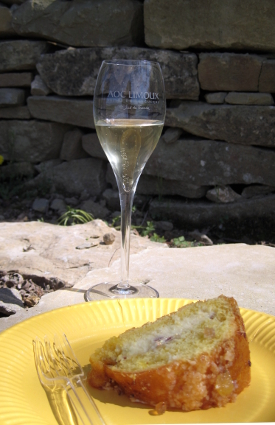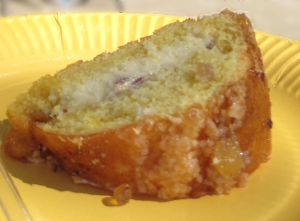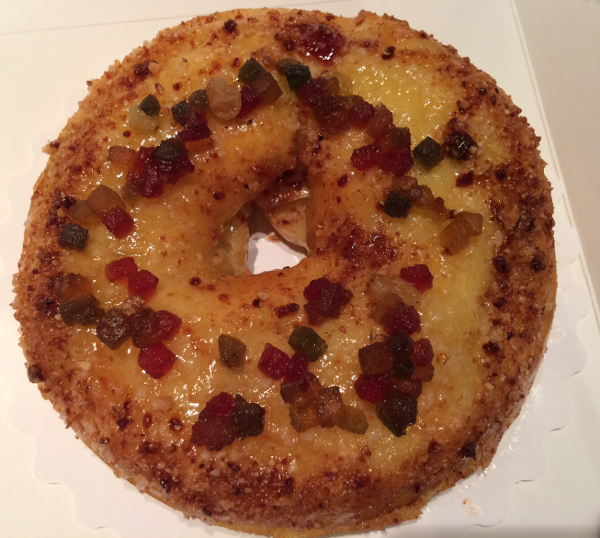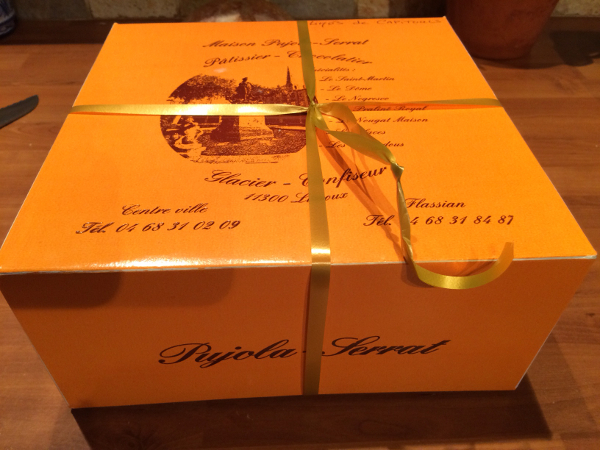Wine with cake? Laissez les bon temps rouler! Fat Tuesday means King Cake, and we have just the recipe and the wine for you to spread the joie de vivre and as you celebrate Mardi Gras festivities!
 In the United States' Christian traditions, Mardi Gras ( Shrove Tuesday or Fat Tuesday) is the Tuesday before Lent when those preparing to fast celebrate with rich fatty foods, wine and perhaps a bit of debauchery. Beads, candy and trinkets fly from parade floats into the hands of welcoming Carnival celebrants and briefly bare-chested women. The call "Hey mister, throw me some beads," can often be answered with "Show us your tits!" But this is all voluntary, and no one takes liberties in bestowing some gaudy golden glitter on an unsuspecting maiden, simply because he has amassed alleged mountains of wealth.
In the United States' Christian traditions, Mardi Gras ( Shrove Tuesday or Fat Tuesday) is the Tuesday before Lent when those preparing to fast celebrate with rich fatty foods, wine and perhaps a bit of debauchery. Beads, candy and trinkets fly from parade floats into the hands of welcoming Carnival celebrants and briefly bare-chested women. The call "Hey mister, throw me some beads," can often be answered with "Show us your tits!" But this is all voluntary, and no one takes liberties in bestowing some gaudy golden glitter on an unsuspecting maiden, simply because he has amassed alleged mountains of wealth.
While the United States' celebrations last a few weeks, in France's Occitania, Pyrenees-Mediterranean region of Limoux the party is just getting started. Dubbed the longest in the world, this year's the Limoux Carnival runs from January 22 to April 2, 2017. It's a tradition carried on for the past 400 years, when 14th Century millers (grinders of food stuffs and grain) celebrated payment of their taxes to Prouille Monastery on a certain Shrove Tuesday. Limoux tradition since then involves not so much a parade, but a kind of dance, governed by rules handed down from generation to generation. Nowadays, on Saturdays and Sundays in January, February and March, 30 or so groups take turns as the masked participants parade through the streets dancing from one cafe to the next. After the third month, the festivities culminate with the Majesté Carnaval and la Nuit de la Blanquette (Night of the Blanquette) when this sparkling wine, which predates Champagne, flows freely.
We first tasted Blanquette de Limoux after a trek through the Languedoc region vineyards, where they served a special cake. They told us it was just after the special Limoux Carnival, but I did not make the connection. When we returned home, I asked Caryl Panman, proprietor of Château Rives-Blanques (along with husband Jan), who makes one of our favorite Blanquette de Limoux, for the recipe. It was then I discovered the origins of our own Mardi Gras King Cake.
Limos and the origins of the Mardi Gras King Cake
The Limos is the Limoux version of the famous French galette des rois, the King Cake, one of the oldest pastries in France, says Caryl. She tells us there are two versions of the cake: the galette and the gateau and every region has its own way of making them. The French consume nearly twenty million of them every year, around Epiphany (celebrated on the second Sunday following the 25th of December). "Limoux's is traditionally a gateau, but quite different from the others," she says.
Traditionally, the youngest person goes under the table, and from there calls the name of whoever he chooses to get the piece that's being sliced above his head. One of those slices will have a bean, or an ornamental charm in it – and the person who gets that is king for the day – and has to buy the next galette.
Ah, that's our Mardi Gras King Cake, I say to her! She tells me its origins:
 This “cake of kings” was first associated with Roman pagan festivals, Caryl says. In the third century BC, the Romans celebrated Saturn, the god of grain and agriculture, in a Saturnalian festival of drink and debauchery. A round and golden cake made its appearance then, in which was hidden a white or black legume bean. If a slave – who had been made noble for the feast days – found the bean in his slice, he was crowned King for a day, and then ... put to death after the party was over.
This “cake of kings” was first associated with Roman pagan festivals, Caryl says. In the third century BC, the Romans celebrated Saturn, the god of grain and agriculture, in a Saturnalian festival of drink and debauchery. A round and golden cake made its appearance then, in which was hidden a white or black legume bean. If a slave – who had been made noble for the feast days – found the bean in his slice, he was crowned King for a day, and then ... put to death after the party was over.
"Not very nice," she says.
But then the King Cake tradition evolved. Byzantine monks in the 14th century adopted a tradition of sharing a “cake of kings.” But instead of cake, they made a brioche, and hid a little coin or trinket in it. At Epiphany, whoever got the lucky slice was made Chapter Master. Limoux's famous version is also a brioche.
Caryl tells us that the original recipe of the frangipane cake, a great puff of pastry filled with almond paste, butter and sugar (the galette), is attributed to Pompeo Frangipani, Marshal of France under Louis XIII in the sixteenth century. The Italian marquis invented a perfume made from almonds. His pastry chef was inspired to use it as a flavoring for the cream in the cake. Catherine de Medici, second wife of Henry II, then imported the recipe to France.
"Over time, the bean inside the cake became a porcelain bean," she says. These days, she tells us, almost anything goes.
"There's a baker in Calvados who advertises that two of his galettes des rois have a solid gold bar worth €400 (about $425 US) in them - possibly inspired by the famous fairytale, written by Charles Perrault in 1694, in which Princess Donkey Skin looses her ring in the dough.
As for Limoux, Caryl tells us, their Galette des Rois is arguably the best version, "and certainly the most fattening," she says.
"Whereas most places will eat their King Cake around Epiphany, Limoux will continue serving it up throughout carnival. Here we have the added advantage that Limoux's carnival is the longest in the world: it begins around January, and ends the Sunday before Palm Sunday – that's three whole months of Limos eating!" Caryl kindly gave us a recipe for the Limos.
Gâteau des rois aux fruits confits, the Limos (King's Cake with Candied Fruits)
Ingredients:*
 1 lemon
1 lemon
1 orange
50 g sugar, Sugar crystals for decoration, Candied fruit
50 g butter
pinch of salt
25 g rum plus rum for macerating fruit
50 g water
250 g orange flower water
250 g flour
2 eggs plus egg yolk for brushing
10 g yeast
*use a digital scale if you usually consult recipes in American cooking measurements. Don't know which one to buy? Try here.
Directions:
Mix zest from 1 orange and 1 lemon in 50 g of sugar.
Slowly bring the zested sugar to the boil with 50 g of butter, a pinch of salt, 25 g of rum, 50 g of water. When it reaches boiling point, add 250 g orange flower water, and leave the syrup to cool slightly (to 40 degrees C or 100 degrees Fahrenheit)
Beat together 250 g of flour, 2 eggs and 10 g baking yeast that has been dissolved (in 120 g of warm water)
Knead gently, slowly adding half the warm syrup,allow the flavors to blend, then add the remaining syrup slowly, still kneading. Knead about 15 mins in total.
By now the dough should be quite elastic. Leave it a couple of hours at room temperature to double in size.
Punch down, Make into a ball and put in the refrigerator for 12 hours.
In the meantime, macerate your candied fruits in rum for 12 hours (and drain before using).
Then (the following day) roll and fold the dough into a ball and roll this ball around gently until a little crease or fold forms on the underside. Leave it to rest, then turn upside down (crease downwards)
Roll out with a rolling pin and form into a crown.
Pierce the top, and tap it with your wrist as you turn it around.
Leave it to rest. Your crown should be about 24 cm wide. Then gently stretch the crown until it is 24 cm wide. Put on baking paper, flatten it gently with your fingers, leave to rest for 3 hours, brush with egg yolk, decorate with more chopped up candied fruits and sugar, and cook for 20 minutes at over preheated to 180 degrees Centigrade (350 degree Fahrenheit). If the oven gets a bit hot, put a piece of waxed paper over the top. When ready, cut through the middle, fill with custard cream and some candied fruit ... and the trinket.
King Cake Pairing: Blanquette de Limoux
 Blanquette de Limoux originated in the Middle Ages, nearly 100 years before Dom Pérignon was born, and years before Champagne became the wine of celebrations. Blanquette de Limoux originated in the Middle Ages, when a Benedictine monk discovered that wine he had bottled and carefully stoppered with a cork appeared to be going through a second fermentation! Some say that was in 1531. According to historians the oldest manuscript of certified origin mentioning “bottles of Blanquette” from the Abbey Saint-Hilaire was an accounts ledger dated 1544.
Blanquette de Limoux originated in the Middle Ages, nearly 100 years before Dom Pérignon was born, and years before Champagne became the wine of celebrations. Blanquette de Limoux originated in the Middle Ages, when a Benedictine monk discovered that wine he had bottled and carefully stoppered with a cork appeared to be going through a second fermentation! Some say that was in 1531. According to historians the oldest manuscript of certified origin mentioning “bottles of Blanquette” from the Abbey Saint-Hilaire was an accounts ledger dated 1544.
While the production area for Cru Limoux was first delineated as early as 1929, Languedoc’s first controlled appellation; Blanquette de Limoux and Blanquette Méthode Ancestrale was noted by decree on February 18, 1938, making it one of France’s first appellations. The traditional grape of Limoux is Mauzac, also known as “Blanquette” meaning small white, due to the fine white down on the underside of its leaves. Blanquette de Limoux can contain three grape varieties: Mauzac (which must constitute a minimum of 90% of the wine), Chardonnay, and Chenin blanc.
As mentioned above, one of our favorites is Château Rives-Blanques Banquette de Limoux, which is 100% Mauzac. For more information on this and other sparkling wines from Limoux please read our previous article Celebrate Your Love with Sparkling Wine from Limoux! For more information on Château Rives-Blanques, please visit their website here. And to learn more about the three months of Limoux Carnival festivities in the South of France, visit here.
If you live in the Houston, Texas area, you can purchase Château Rives-Blanques Banquette de Limoux at French Country Wines, in the Rice University Village Area on Bartlett, near Goode Company Barbecue. We always have several bottles on hand!
If you're lucky enough to get to Limoux, stop by Maison Pujola Serrat and pick up a delicious cake for yourself! Thanks to Caryl Panman for recipe and photos below.


Cheers!
The WineWonkette

